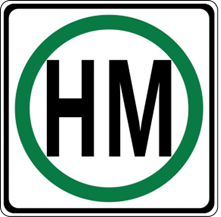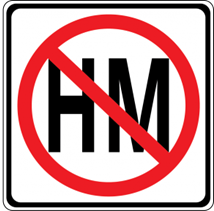Hazardous Material Routes For Non-Radioactive Hazardous Materials (NRHM)
The following information is intended and provided as guidance only. For complete classification and transport and safety rules you must consult EPA, DOT, OSHA, State, Local and other applicable rules and regulations.
ETR and its instructors accept no responsibility for the typographical errors, references, errors and omissions.
When do loads of Hazardous Materials have to follow Hazardous Material routes? The simple answer is Almost Always and if you are unsure follow the routes.
In this article we will take a more detailed look at when drivers carrying NRHM (Non-Radioactive Hazardous Materials) must follow designated Hazardous Material routes and when they are not required to.
Hazardous Material Transportation Permit
Hazardous Material Transportation Prohibited
You may ask, “What is a NRHM?” NRHM are materials which meet any of the nine DOT hazard class definitions1 except class 7 which is for Radioactive materials. A brief description follows:
Class 1 – Explosives
Class 2 – Compressed Gases -flammable, non-flammable, and toxic
Class 3 - Flammable liquids
Class 4 – Flammable Solids, spontaneously combustible, Dangerous when wet
Class 5 – Oxidizers and Organic Peroxides
Class 6 – Poisons and Infectious substances
Class 8 – Corrosives
Class 9 – Miscellaneous Hazardous Materials
Most larger cities and densely populated counties restrict movement of hazardous materials through densely populated areas.
Routing rules for Non-Radioactive Hazardous Materials are found in 49 CFR Part 397 Subpart C of the Federal Motor Carrier Rules2 for Hazardous Materials Transportation. As mentioned earlier almost all NRHM must follow Hazardous Material (sometimes referred to as Hazardous Cargo routes) however, there are exceptions. We will take a closer look at the exceptions.
First, we will look at the Applicability of Part 397 which states:
“The rules in this part apply to each motor carrier engaged in the transportation of hazardous materials by a motor vehicle which must be marked or placarded in accordance with § 177.823 of this title …”. 177.823 addresses marking and placarding of transport vehicles.
Sooo, In the instances when marking and placarding the transport vehicle is not required Hazardous Materials Routes are not applicable to load movement.
49 CFR 177.823 refers to the marking and placarding requirements located in Part 172 (Stay with me we will get there I promise).
So, if 49 CFR Part 172 requires you to mark or placard the load then you must follow the Part 397 rules which includes routing requirements.
Second, we will review transport vehicle (load) marking and placarding requirements. The best way to understand when you do not have to mark or placard a load is to look at the rules which require marking and placarding.
Marking in 172 Subpart D requires:
Ø All hazardous materials shipped in bulk packages to be marked with the ID # Therefore all bulk packages containing hazardous materials have to follow Hazardous Material routes.
Ø Typically (with just a few exceptions), freight containers and trailers on transport vehicles which contain non-bulk packages do not require an ID# marking on the outside of the container or trailer.
Ø That said most will still be required to follow hazardous materials routes due to the placarding requirement.
Placarding in 172 Subpart F
Ø For non-bulk packages (typically 119 gallons or less) placarding exceptions include:
· Transport vehicles and freight containers which contain only certain hazard classes and divisions in Table 2 of section 172.504 with an aggregate gross weight of < 1.001 lb.s or 454 kgs. as detailed in 172.504(c)
· Class 9 materials 172.504(f)(9)
Conclusion:
Certain smaller quantities (i.e. < 1,001 lbs. of table II materials) of non-bulk packages and class 9 materials which do not require placards or markings on the transport vehicle are not required to follow hazardous materials routes.
It must be reiterated however, local, county, state, or municipal ordinances may further restrict movement.
Summary:
In general:
Ø All bulk packages of Hazardous Materials must follow the Hazardous Materials routing requirements in Part 397.
Ø Non-bulk packages which are required to be placarded must also follow Hazardous Materials routing requirements
Ø Exceptions for non-bulk packages which would exempt them from the requirements include
· Class 9 materials
· < 1,001 lb.s of table 2 materials
Ø Reasonable deviations are allowed to reach terminals, points of loading and unloading, facilities for food, fuel, repairs, rest, or a safe haven.
Footnotes:
1 49 CFR 171.8 Definitions
2 49 CFR Part 397
References:
49 CFR
171.8 – definitions
390.5 - definitions
Part 172 Subpart F – Placarding
Part 397 Subpart C – Routing of Non-Radioactive Hazardous Materials


